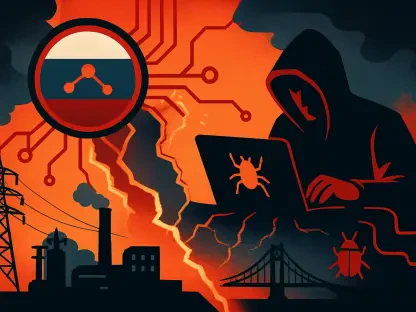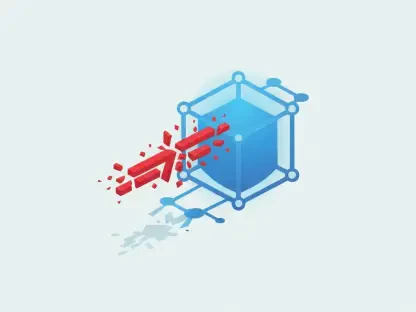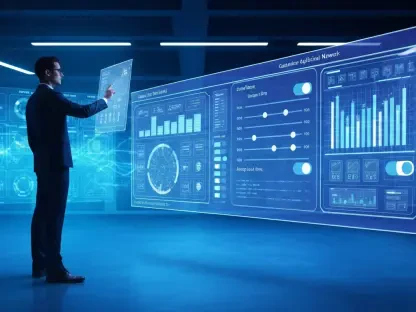Artificial intelligence (AI) has been heralded as a game-changer in many fields, and cybersecurity is no exception. The promise of AI in this domain is immense, with potential applications ranging from threat detection to automated response systems and more. However, the question remains: can AI truly transform cybersecurity, or does it merely level the playing field between attackers and defenders? Understanding the nuanced role of AI in this ever-evolving landscape is crucial for both leveraging its full potential and addressing its limitations.
The Symmetric Advantage of AI
AI for Attackers and Defenders
The capabilities of AI present a double-edged sword in the realm of cybersecurity, where both attackers and defenders can harness its power to enhance their operations. On one hand, defenders benefit from AI’s ability to analyze vast amounts of data, identify potential threats, and automate responses swiftly and efficiently. Techniques such as machine learning allow for the detection of anomalies within network traffic or user behavior, which might otherwise go unnoticed by human analysts. The automation of routine tasks not only reduces the burden on human analysts but also accelerates the identification and mitigation of threats.
Conversely, attackers have also recognized the potential of AI and are adept at utilizing it to amplify their offensive strategies. AI enables cybercriminals to create more sophisticated phishing schemes, evading traditional detection mechanisms through more convincing and targeted attacks. AI-driven tools can swiftly scan networks for vulnerabilities, enabling attackers to identify weaknesses at a much faster rate than before. Additionally, AI-driven malware can adapt in real-time, learning from failed attempts to breach systems and modifying its methods to avoid detection. This dynamic creates a perpetual arms race, forcing both sides to continuously innovate and refine their tactics.
Enhancing Capabilities
For defenders, the integration of AI into cybersecurity protocols marks a significant step forward in enhancing their capabilities. AI systems can monitor and process logs from vast arrays of devices, identifying potential threats and delivering real-time alerts to security teams. This proactive approach enables quicker threat detection and a more measured, timely response compared to traditional reactive measures. Furthermore, AI can predict potential attacks based on patterns identified in historical data, allowing defenders to preemptively fortify their defenses against emerging threats.
On the attack front, AI is equally transformative. Cybercriminals have been quick to deploy AI-based tools to automate the discovery of system vulnerabilities, vastly speeding up reconnaissance efforts. This includes the use of AI to generate highly convincing phishing emails that can evade spam filters and trick even the most cautious users. Moreover, AI can be used to develop malware that adapts to the security measures it encounters, making it more resistant to conventional defense mechanisms. This continuous enhancement of capabilities on both sides illustrates the symmetric advantage provided by AI, where the equilibrium in capabilities breeds an ever-escalating conflict between attackers and defenders.
The Reluctance Gap
Fear of Change
Despite AI’s clear benefits in enhancing cybersecurity measures, many organizations remain hesitant to fully embrace this technology. This reluctance gap often stems from a fear of change, rooted in concerns over the unknown implications of integrating new AI systems into existing security infrastructures. Organizations may fear disruption to established workflows or doubt the reliability and accuracy of AI-driven solutions compared to traditional methods. This apprehension can stall progress and result in organizations clinging to outdated security protocols, opening potential loopholes for adversaries to exploit.
Moreover, the fear of AI-based false positives or negatives can contribute to this reluctance. Security leaders may worry about the ramifications of an AI system incorrectly flagging benign behavior as a threat, potentially leading to unnecessary disruptions and resource allocations. Conversely, there are concerns about AI failing to detect subtle intrusions, leading to potential security breaches. Overcoming these fears requires a robust understanding of AI’s capabilities and limitations, as well as a strategic approach to its implementation within the broader security framework.
Institutional Inertia
Another formidable barrier to the adoption of AI in cybersecurity is institutional inertia. Large organizations often have deep-seated processes and legacy systems that resist change. The introduction of AI requires not just technological adaptations but also significant cultural shifts within the organization. Employees need to be retrained, workflows must be restructured, and there must be an overall shift in mindset towards accepting and integrating AI-driven solutions. This inertia can be a critical stumbling block, as sticking to traditional practices can leave organizations vulnerable to increasingly sophisticated cyber threats.
Institutional inertia is compounded by bureaucratic decision-making processes, which can slow down the adoption of new technologies. Approval cycles for acquiring and implementing AI systems may be lengthy, with various departments needing to sign off on the changes. During this time, cyber threats continue to evolve, outpacing the slow-moving adoption of defenses. Overcoming this inertia involves fostering a culture of continuous improvement and innovation, ensuring that organizations remain agile and responsive to the fast-paced landscape of cybersecurity threats. Leadership must champion the adoption of AI and drive cultural changes that embrace technological advancements.
Cybersecurity as a Data Search Problem
The Role of Data
In the contemporary landscape of cybersecurity, data serves as the primary battleground where the war against cyber threats is fought. The effectiveness of AI in enhancing security measures hinges fundamentally on the quality and quantity of data it is trained on. Attackers often rely on data that can be observed or simulated, which, while valuable, is inherently limited in scope. Their models might be derived from reverse-engineered scenarios or common attack vectors, providing a restricted view of the potential landscape of vulnerabilities.
Defenders, on the other hand, possess a unique advantage in having access to proprietary and often more comprehensive data sets. This data might include internal network traffic logs, historical incident reports, and other sources that are not readily accessible to external attackers. By harnessing this expansive and often exclusive data, defenders can train AI models with a broader and more nuanced understanding of potential threats. This superior dataset equips AI systems to detect and respond to threats with heightened accuracy and precision, shifting the balance of advantage towards those with the most robust and comprehensive data.
Leveraging Proprietary Data
To secure a significant advantage in the cybersecurity domain, defenders must strategically leverage proprietary or otherwise inaccessible data when training their AI models. Utilizing this exclusive data allows for a more nuanced view of potential threats, enabling defenders to uncover security vulnerabilities that would remain invisible to attackers working with more limited datasets. This approach places defenders on higher ground, offering a broader scope of visibility and enhanced threat detection capabilities.
By capitalizing on diverse and comprehensive datasets, defenders can build more sophisticated models that anticipate and mitigate potential threats before they manifest. Proprietary data often includes unique insights and context that external adversaries cannot replicate, providing an upper hand in the AI-driven cybersecurity arms race. Furthermore, ongoing refinement and updating of AI models with the latest internal data ensure that defenders remain a step ahead of attackers who cannot access this privileged information. In essence, the strategic use of proprietary data transforms AI from a leveling tool into a decisive factor in maintaining security superiority.
Reluctance as a Risk
Simplification and Reduction
Organizations frequently prioritize simplifying their technology stack, reducing agent proliferation, or cutting headcount as part of cost-saving measures. However, when driven by reluctance to adopt new technologies rather than strategic necessity, such measures can inadvertently introduce vulnerabilities. Simplification for its own sake may lead to the elimination of effective tools or strategies that could be pivotal in defending against sophisticated cyber threats. The desire to streamline operations should not overshadow the necessity of maintaining a robust and multifaceted security posture.
When organizations cut back on their security infrastructure without adequately considering the consequences, they risk creating blind spots that attackers can exploit. For instance, reducing the number of security agents or aggregating multiple functionalities into a single tool may compromise the overall effectiveness of the security apparatus. As cyber threats continue to evolve in complexity and frequency, any reduction in defensive capabilities could leave organizations exposed to greater risks. It is essential that any simplification or reduction measures are carefully balanced with the strategic need to maintain comprehensive and effective security strategies.
Resistance to Change
Resistance to change remains one of the most critical vulnerabilities in the field of cybersecurity. As adversaries constantly evolve their tactics and techniques, a static or rigid approach to security can quickly become obsolete. Organizations that fail to adapt to new methodologies or integrate emerging technologies like AI are left ill-equipped to handle the dynamic nature of cyber threats. Embracing change and continuously updating security protocols is essential for maintaining a strong defense against increasingly sophisticated attacks.
Overcoming this resistance requires a concerted effort to foster a culture of innovation and flexibility within the organization. Security teams must be encouraged to explore and adopt new tools and strategies, even if it means departing from established norms. The willingness to take calculated risks and learn from failures is crucial for staying ahead in the cybersecurity arms race. By addressing the root causes of resistance to change, organizations can better position themselves to respond effectively to the ever-evolving threat landscape. This proactive approach ensures that defenses remain robust and capable of thwarting advanced cyber threats.
Continuous Adaptation
The Need for Flexibility
Cybersecurity is inherently dynamic, requiring continuous adaptation to counter ever-evolving threats. Static defense mechanisms quickly lose their effectiveness as attackers innovate and find new ways to bypass traditional security measures. To stay ahead in this cat-and-mouse game, organizations must embrace flexibility in their security strategies. This involves not only updating technologies and tools but also continuously refining methodologies and best practices to stay aligned with the latest threat intelligence and attack vectors.
The need for flexibility extends to every level of an organization’s security posture. From frontline security operations to strategic planning, there must be an ongoing commitment to agility and adaptability. This includes regular training and upskilling of security personnel, ensuring they are equipped with the latest knowledge and techniques to combat emerging threats. Additionally, organizations must invest in scalable and adaptable security infrastructures that can quickly adjust to new challenges. By maintaining a flexible approach, organizations can more effectively anticipate and mitigate cyber threats, rather than merely reacting to them.
Embracing Innovation
Innovation is key to staying ahead in the relentless cybersecurity arms race. Organizations must not only adopt new technologies like AI but also cultivate a culture of continuous improvement and learning. This involves encouraging security teams to experiment with new approaches, take calculated risks, and adapt to emerging challenges. By fostering an environment where innovation is valued and supported, organizations can maintain a proactive rather than reactive security posture.
To embrace innovation, security teams should be empowered to explore cutting-edge technologies and integrate them into their existing frameworks. This includes leveraging advanced AI-driven analytics, automating routine security tasks, and experimenting with novel threat detection methodologies. Moreover, organizations should establish feedback loops where security personnel can share insights and learn from each other’s experiences. This collaborative approach enhances the collective intelligence of the organization, driving continuous improvement in security measures. By prioritizing innovation and adaptability, organizations can better navigate the complex and ever-shifting landscape of cybersecurity threats.
The Strategic Use of AI
AI as a Tool, Not a Panacea
While AI brings powerful capabilities to the field of cybersecurity, it is important to recognize that it is not a cure-all for the challenges faced by security teams. AI should be viewed as a tool that enhances human expertise rather than replacing it altogether. Effective utilization of AI requires a strategic approach that integrates it into a broader security framework, one that includes human oversight and continuous improvement. AI can augment the efforts of security professionals by providing valuable insights and automating routine tasks, but it should not be relied upon as the sole line of defense.
Humans play a crucial role in interpreting AI-generated insights and making informed decisions based on them. AI systems can analyze vast amounts of data and identify potential threats, but the context and nuanced understanding of human analysts are essential for accurate threat assessment and response. By combining the strengths of AI with the expertise of human security professionals, organizations can develop a more resilient and effective defense strategy. This hybrid approach ensures that AI serves as a potent ally in the fight against cyber threats rather than an infallible solution.
Training and Expertise
Artificial intelligence (AI) is widely regarded as a revolutionary force across numerous sectors, and cybersecurity is no different. The potential of AI in enhancing cybersecurity is vast, with applications that include, but are not limited to, threat detection, vulnerability assessment, and automated response mechanisms. AI can identify patterns and anomalies faster and more accurately than traditional methods, significantly improving the ability to anticipate and neutralize threats. However, a significant debate persists: does AI fundamentally transform cybersecurity into a more secure environment, or does it just provide criminals with equally sophisticated tools, thus balancing the scale between attackers and defenders? It’s essential to grasp the complex and nuanced role of AI in cybersecurity. Understanding these dynamics is key for harnessing AI’s full capabilities while also being aware of its limitations. Addressing these challenges involves continuously evolving strategies and robust frameworks to stay ahead in this cat-and-mouse game.









